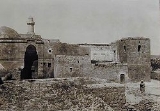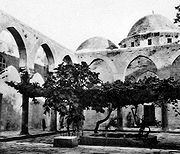
Al-Firdaws Madrasa
Encyclopedia
Al-Firdaws Madrasa is a madrasah
complex located southwest of Bab al-Maqam
in Aleppo
, Syria
. It is the largest and best known of the Ayyubid madrasas in Aleppo. Due to its location outside the city walls, the madrasa was developed as a freestanding structure.
era of rule in Syria. Its patron was Dayfa Khatun
, the wife of the Ayyubid governor of Aleppo, al-Zahir Ghazi
. She was the queen of the region between 1236-1243 and one of the most prominent architectural patrons in Syrian history
; she established large endowments for the maintenance and operation of her charitable foundations. Although built by the Ayyubids, Roman
and Byzantine
heritage of Aleppo is reflected in the madrasa as it is the only one with an arcaded courtyard.
 The Ayyubid building has a stark facade that appears as a solid mass of stone, with eleven domes. Although the madrasa has four entrances, three of the secondary ones are now blocked up, leaving the main eastern entrance as the only current entry point inside. The main entrance is typical of Ayyubid architecture, with its elongated and narrow proportions and three-tiered muqarnas
The Ayyubid building has a stark facade that appears as a solid mass of stone, with eleven domes. Although the madrasa has four entrances, three of the secondary ones are now blocked up, leaving the main eastern entrance as the only current entry point inside. The main entrance is typical of Ayyubid architecture, with its elongated and narrow proportions and three-tiered muqarnas
vault.
Through a vaulted corridor, the portal leads to the rectangular courtyard of al-Firdaws. Three large chambers and residential cells are arranged around the rectangular courtyard, which is enveloped by an arcade (riwaq
) on the eastern, western and southern sides, with a large iwan
on the northern side. The columns have muqarnas capitals. The Roman
and Byzantine
heritage of Aleppo is reflected in this Ayyubid madrasa as it is the only one with an arcaded courtyard.
Firdaws's double-sided iwan is similar to those in madrasas in Baghdad
, palatial structures in Mardin
, and early Islam
ic palaces in Samarra
, tracing its origins to the palatial typology. Residential cells are located in the northeastern and northwestern parts of the building.
. The structure has two domes on the corner bays. All the domes were built alike, except for the mihrab
dome, which has an elaborate muqarnas base and twelve small openings. The mihrab is made of veined white marble, red porphyry
and green diorite
. Its niche is composed of granite columns with muqarnas capitals.
Madrasah
Madrasah is the Arabic word for any type of educational institution, whether secular or religious...
complex located southwest of Bab al-Maqam
Bab al-Maqam
Bab al-Maqam is one of the Gates of Aleppo. It was built by al-Aziz Muhammad in 1230 on the road that connected the Maqamat with the Citadel. It is unique in its planning and form. The design's innovative quality implies a monumental, ceremonial function rather than a military one.Yasser Tabbaa...
in Aleppo
Aleppo
Aleppo is the largest city in Syria and the capital of Aleppo Governorate, the most populous Syrian governorate. With an official population of 2,301,570 , expanding to over 2.5 million in the metropolitan area, it is also one of the largest cities in the Levant...
, Syria
Syria
Syria , officially the Syrian Arab Republic , is a country in Western Asia, bordering Lebanon and the Mediterranean Sea to the West, Turkey to the north, Iraq to the east, Jordan to the south, and Israel to the southwest....
. It is the largest and best known of the Ayyubid madrasas in Aleppo. Due to its location outside the city walls, the madrasa was developed as a freestanding structure.
History
Al-Firdaws was built in 1235-36, during the AyyubidAyyubid dynasty
The Ayyubid dynasty was a Muslim dynasty of Kurdish origin, founded by Saladin and centered in Egypt. The dynasty ruled much of the Middle East during the 12th and 13th centuries CE. The Ayyubid family, under the brothers Ayyub and Shirkuh, originally served as soldiers for the Zengids until they...
era of rule in Syria. Its patron was Dayfa Khatun
Dayfa Khatun
Dayfa Khatun was the regent ruler of Aleppo from 1237 to 1244 during the reign of her grandson an-Nasir Yusuf. She achieved an unprecedented measure of autonomous political influence, becoming the first Ayyubid female regent, and played a major role in architectural patronage in Aleppo, being...
, the wife of the Ayyubid governor of Aleppo, al-Zahir Ghazi
Malik az-Zahir
Az-Zahir Ghazi was governor and then ruler of Aleppo from 1186 to 1216. He was the third son of Saladin and his lands included northern Syria and a small part of Mesopotamia....
. She was the queen of the region between 1236-1243 and one of the most prominent architectural patrons in Syrian history
History of Syria
The history of Syria:*Prehistory and Ancient Near East: see Pre-history of the Southern Levant, Fertile Crescent, Ebla, Mitanni*Antiquity: see Syro-Hittite states, Greater Syria, Roman Syria...
; she established large endowments for the maintenance and operation of her charitable foundations. Although built by the Ayyubids, Roman
Roman Empire
The Roman Empire was the post-Republican period of the ancient Roman civilization, characterised by an autocratic form of government and large territorial holdings in Europe and around the Mediterranean....
and Byzantine
Byzantine Empire
The Byzantine Empire was the Eastern Roman Empire during the periods of Late Antiquity and the Middle Ages, centred on the capital of Constantinople. Known simply as the Roman Empire or Romania to its inhabitants and neighbours, the Empire was the direct continuation of the Ancient Roman State...
heritage of Aleppo is reflected in the madrasa as it is the only one with an arcaded courtyard.
Facade and courtyard

Muqarnas
Muqarnas is a type of corbel used as a decorative device in traditional Islamic architecture. The term is similar to mocárabe, but mocárabe only refers to designs with formations resembling stalactites, by the use of elements known as alveole.Muqarnas takes the form of small pointed niches,...
vault.
Through a vaulted corridor, the portal leads to the rectangular courtyard of al-Firdaws. Three large chambers and residential cells are arranged around the rectangular courtyard, which is enveloped by an arcade (riwaq
Riwaq
A riwaq is an arcade or portico open on at least one side. Such structures are built in Iran and other Islamic countries, mostly in the bazaars or mosques....
) on the eastern, western and southern sides, with a large iwan
Iwan
An iwan is a rectangular hall or space, usually vaulted, walled on three sides, with one end entirely open. The formal gateway to the iwan is called pishtaq, a Persian term for a portal projecting from the facade of a building, usually decorated with calligraphy bands, glazed tilework, and...
on the northern side. The columns have muqarnas capitals. The Roman
Roman architecture
Ancient Roman architecture adopted certain aspects of Ancient Greek architecture, creating a new architectural style. The Romans were indebted to their Etruscan neighbors and forefathers who supplied them with a wealth of knowledge essential for future architectural solutions, such as hydraulics...
and Byzantine
Byzantine architecture
Byzantine architecture is the architecture of the Byzantine Empire. The empire gradually emerged as a distinct artistic and cultural entity from what is today referred to as the Roman Empire after AD 330, when the Roman Emperor Constantine moved the capital of the Roman Empire east from Rome to...
heritage of Aleppo is reflected in this Ayyubid madrasa as it is the only one with an arcaded courtyard.
Iwan
The madrasa has a large iwan, or classroom, is across the courtyard from the prayer hall. Its walls are carved with three niches used for book storage. This iwan is backed by a larger iwan that faces north. Though this iwan currently faces a wall due to the dense urban growth around al-Firdaws, it is believed to have been originally open to a walled garden and a large pool.Firdaws's double-sided iwan is similar to those in madrasas in Baghdad
Baghdad
Baghdad is the capital of Iraq, as well as the coterminous Baghdad Governorate. The population of Baghdad in 2011 is approximately 7,216,040...
, palatial structures in Mardin
Mardin
Mardin is a city in southeastern Turkey. The capital of Mardin Province, it is known for its Arabic-like architecture, and for its strategic location on a rocky mountain overlooking the plains of northern Syria.-History:...
, and early Islam
Islam
Islam . The most common are and . : Arabic pronunciation varies regionally. The first vowel ranges from ~~. The second vowel ranges from ~~~...
ic palaces in Samarra
Samarra
Sāmarrā is a city in Iraq. It stands on the east bank of the Tigris in the Salah ad-Din Governorate, north of Baghdad and, in 2003, had an estimated population of 348,700....
, tracing its origins to the palatial typology. Residential cells are located in the northeastern and northwestern parts of the building.
Mosque
The southern chamber of the madrasa is used as a mosqueMosque
A mosque is a place of worship for followers of Islam. The word is likely to have entered the English language through French , from Portuguese , from Spanish , and from Berber , ultimately originating in — . The Arabic word masjid literally means a place of prostration...
. The structure has two domes on the corner bays. All the domes were built alike, except for the mihrab
Mihrab
A mihrab is semicircular niche in the wall of a mosque that indicates the qibla; that is, the direction of the Kaaba in Mecca and hence the direction that Muslims should face when praying...
dome, which has an elaborate muqarnas base and twelve small openings. The mihrab is made of veined white marble, red porphyry
Porphyry (geology)
Porphyry is a variety of igneous rock consisting of large-grained crystals, such as feldspar or quartz, dispersed in a fine-grained feldspathic matrix or groundmass. The larger crystals are called phenocrysts...
and green diorite
Diorite
Diorite is a grey to dark grey intermediate intrusive igneous rock composed principally of plagioclase feldspar , biotite, hornblende, and/or pyroxene. It may contain small amounts of quartz, microcline and olivine. Zircon, apatite, sphene, magnetite, ilmenite and sulfides occur as accessory...
. Its niche is composed of granite columns with muqarnas capitals.
See also
- Al-Zahiriyah MadrasaAl-Zahiriyah MadrasaAl-Zahiriyah Madrasa is a madrasah complex located between the Kamiliyah and the Firdaws madrasas, about south of Bab al-Maqam, in Aleppo, Syria. It was built by Az-Zahir Ghazi in 1217...
- Al-Uthmaniyah MadrasaAl-Uthmaniyah MadrasaAl-Uthmaniyah Madrasa is a madrasah complex located in the northern Bab al-Nasr district of the old city of Aleppo, Syria. It was established by Ottoman Pasha Al-Duraki in 1730 and was originally named Madrasa Ridaiya. The madrasa, which includes a mosque, boasts one of the tallest minarets in...
- Al-Sultaniyah MadrasaAl-Sultaniyah MadrasaAl-Sultaniyah Madrasa is a madrasah complex located across from the Citadel entrance in Aleppo, Syria. It is a religious, educational and funerary complex. It contains the tomb of sultan Malik al-Zaher the son of Ayyubid Sultan Saladin.-See also:...
- Khusruwiyah MosqueKhusruwiyah MosqueThe Khusruwiyah Mosque is a mosque complex in Aleppo, Syria. It is located south of the Citadel, facing its main entrance. The mosque was built under the patronage of the Hüsrev Pasha, while he was serving as the fourth vizier under Sultan Suleiman I...

